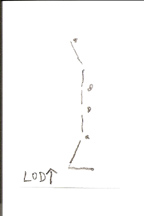I hadn't meant to teach this step last week, but one couple came in with a mild disagreement over how to make it work, and the other dancers were intrigued, and it got added to the intermediate lesson plan. After all, what's not to like about a bit of milonga snuck into tango class?
I learned this step the first year I took tango. In fact, I think we ALL learned this step that year, 1995-1996, because I remember being led in it ad nauseam, and swearing I'd never teach the move again. Ah, well, life is more fun when you reverse your decisions randomly!
Main concept
The leader blocks the follower's leg so that, instead of walking backwards, the follower has to change weight by crossing the right leg in front of the left leg (the reverse of the "normal" cruzada position). This is repeated several times (three feels nice), and then the leg block is released to walk the follower to the cross. Many people like to use a slight rocking motion to travel/change weight during this move, which is probably why it's called drunken sailor.
Because this step relies on full body contact to lead nicely, I wouldn't do this in open embrace: it leads to karate-like chops towards the follower's legs, which do NOT feel nice. Ease into this step; it's only a slightly drunken sailor! Think rocking boat, not staggering drunk.
Getting into the step
I like leading into the drunken sailor from the salida. Of course, there are other ways, but I'll leave you to figure those out.
- Leader steps to the left with the left.
- Step forward and slightly to the right diagonal with the right, making sure to contact the outside of the follower's right thigh with the outside of the leader's right thigh.
- While doing #2, the leader rotates a bit, so that the leader's hips face slightly left forward diagonal. This makes it easier for both people to arrive in the correct, balanced position to switch feet.
- The leader steps in and behind with, the left so that the knees "kiss"--but the feet don't. By overshooting a bit, and then shifting the hips, this step shifts a teeny bit to the leader's right. This ensures that the follower MUST shift weight, crossing to the "wrong" side.
- Repeat 3. and 4. two more times (optional), continuing down the line-of-dance. The hip shifts tilt the dancers from one foot to the other, making this step look drunken. Don't overdo it, and make sure that the lead is from the center, not from the arms or shoulders. It's supposed to look drunken, not dangerous.
Exiting from the step
Once the follower understands that you are doing the drunken sailor, continuing the step is easy. However, convincing the follower that you want to STOP the move takes a clear lead.
- Stop touching legs: as the leader travels forward with the right, make sure your legs do not touch.
- Reverse the diagonal: as the leader travels forward with the left, make the step move out SLIGHTLY to the left front diagonal (facing LOD), and make sure you have rotated the follower so that it is obvious that something else is happening.
- Lead the follower into the regular cruzada, crossing the follower's LEFT over the right (of course, there are other ways to exit, but this is the easiest).
This is a traveling step
This does not travel in a straight line (notice the name!), but it does end up making a normal progression down the LOD. I can't explain what it looks like, so I will have to draw a picture of it:
In my mind, this is what I say to translate this picture (you need to start at the bottom and work up--sorry, this is how I notate dances for myself!):
- side
- forward
- shift in place
- forward
- shift in place
- forward
- shift in place
- forward
- to the
- cross!
As long as the move continues line-of-dance (LOD), it works on the dance floor. There are two main variants I've seen, one in which the leader does a crab walk down the LOD, with the hips facing slightly left front diagonal. In the other version, the leader faces the center of the room, and moves sideways down the line of dance. I like moving down the room in diagonals, rather than facing in. Yes, facing into the room is probably an easier way to get that first reverse cross from the follower, but it's harder to exit elegantly.
Adjusting for height
Not everyone is the same height, so sometimes "thigh" needs to be a relative term. I aim to contact the follower's leg near the height of the hip joint, so I can move the follower's leg through space without upsetting the follower's balance. That means that a short leader may need to aim higher than their own thigh, and a tall leader may need to use just above the knee in order to contact the follower at the upper thigh. If you have a really tall follower, make sure you don't take them out at the knee by mistake!!
Taadaa!

